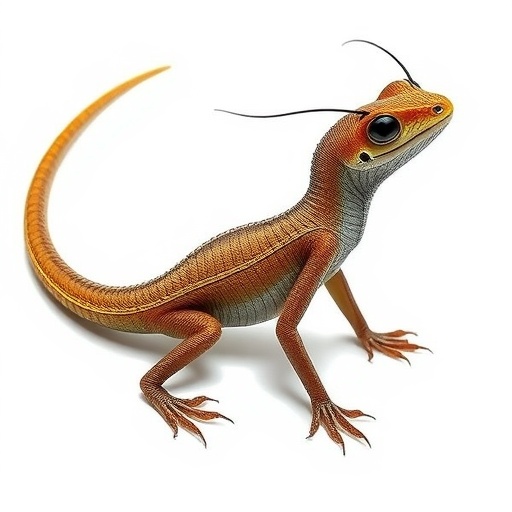
In a groundbreaking study, researchers have achieved a significant milestone in the field of evolutionary biology by unveiling the mitochondrial genome of the fish species Monodactylus sebae. This newly sequenced genome not only enriches our understanding of the genetic landscape of this intriguing fish but also contributes critical insights into its phylogenetic relationships within the Eupercaria clade. The study authored by Chen, Sun, and Lu provides a comprehensive analysis of the mitochondrial DNA, which serves as a vital tool in the examination of evolutionary trajectories among teleost fishes.
Monodactylus sebae, commonly encountered in coastal regions across the Indo-Pacific, is notable for its striking appearance, possessing a laterally compressed body and a distinctive silver coloration. Beyond its aesthetic appeal, this fish species embodies complex genetic characteristics that have often remained obscured due to incomplete genomic data. The authors meticulously sequenced the mitochondrial genome, revealing its structure and composition, which lays the groundwork for further studies into its functional genomics and evolutionary history.
The mitochondrial genome, a crucial component of the cellular machinery responsible for energy production, contains genetic information pivotal for oxidative phosphorylation. The research team utilized advanced sequencing technologies to decode the entire mitochondrial DNA, uncovering 13 protein-coding genes, two ribosomal RNA genes, and 22 transfer RNA genes. The completeness of the mitochondrial genome is anticipated to facilitate a deeper comprehension of the evolutionary mechanisms that have shaped the radiation of Monodactylidae, the family to which M. sebae belongs.
The phylogenetic analysis performed in this study is particularly striking, as it places M. sebae within the broader context of Eupercaria, a diverse clade of ray-finned fishes. The authors employed both maximum likelihood and Bayesian inference methods to construct a robust phylogenetic tree, enabling them to illustrate the evolutionary relationships between M. sebae and other significant taxa within the Eupercaria group. Such analyses shed light on the ancient diversification events that contributed to the current diversity of teleost fish, highlighting the intricate web of relationships that define marine biodiversity.
Furthermore, the study examines the evolutionary pressures that may have influenced the mitochondrial genome of M. sebae. Notably, the researchers discuss the implications of environmental adaptability and its reflective selection pressures on the genome. The adaptive evolution of mitochondrial genes is a critical factor for survival in diverse marine environments, and understanding these dynamics could illuminate how species like M. sebae thrive despite the backdrop of ongoing environmental change.
In addition, this research underscores the importance of mitochondrial studies in uncovering evolutionary patterns across species that may appear morphologically similar but are genetically distinct. The contrasting genetic profiles among closely related species often reveal surprising evolutionary histories, and the sequencing of M. sebae’s genome is a step toward documenting these cryptic diversifications. Thus, this work not only pertains to M. sebae but also has broader implications for the field of systematics and conservation.
Moreover, the findings prompt a reconsideration of the classification schemes within the family Monodactylidae. The nuanced phylogenetic placement of M. sebae emerged as an intriguing point for further exploration, as it challenges previously held notions regarding the relationships within this group of fishes. As such, the authors suggest that future taxonomic revisions may be necessary to accurately reflect these discoveries, which could ultimately influence conservation strategies focused on preserving genetic diversity within marine species.
The study’s implications extend beyond phylogenetics; they resonate within the realm of marine ecology as well. With oceanic conditions continuously evolving due to climate change, understanding the genetic underpinning of species like M. sebae provides critical insights into how marine organisms may respond to shifting environments. This knowledge is instrumental in developing conservation frameworks aimed at mitigating the impact of anthropogenic factors on marine biodiversity and ensuring the survival of vulnerable species.
As the scientific community grapples with the challenges posed by declining fish populations worldwide, this research reinforces the imperative for further genomic studies of economically and ecologically important fish species. The sequencing of mitochondrial genomes serves as a foundational step that equips marine biologists and conservationists with data essential for informed decision-making regarding sustainable fishing practices and habitat preservation.
Additionally, the methodology employed in this study sets a precedent for future research endeavors within the sphere of molecular phylogenetics. The integration of cutting-edge sequencing platforms and analytical techniques exemplifies the potential for dissecting complex evolutionary narratives that have remained enigmatic for decades. The adoption of innovative approaches to mitochondrial genome sequencing paves the way for expanded genetic explorations across diverse taxa, thereby enriching our understanding of life’s evolutionary tapestry.
In conclusion, the sequencing of the mitochondrial genome of Monodactylus sebae by Chen, Sun, and Lu represents a monumental leap in both the field of evolutionary biology and the understanding of marine biodiversity. This study not only elucidates the phylogenetic placement and genetic profiles of M. sebae but also emphasizes the relevance of such genomic explorations in confronting contemporary ecological and conservation challenges. As the quest for knowledge continues, the implications of this research resonate widely, inspiring future inquiries that may illuminate further aspects of our planet’s intricate biological heritage.
Subject of Research: Phylogenetic characteristics of Monodactylus sebae
Article Title: Phylogenetic Characteristics of a Newly Sequenced Mitochondrial Genome of Monodactylus sebae (Eupercaria, Monodactylidae)
Article References:
Chen, XD., Sun, CH. & Lu, CH. Phylogenetic Characteristics of a Newly Sequenced Mitochondrial Genome of Monodactylus sebae (Eupercaria, Monodactylidae).
Biochem Genet (2025). https://doi.org/10.1007/s10528-025-11185-1
Image Credits: AI Generated
DOI: 10.1007/s10528-025-11185-1
Keywords: Mitochondrial genome, phylogenetics, Monodactylus sebae, Eupercaria, marine biodiversity, evolutionary biology, conservation.
Tags: coastal Indo-Pacific fish speciesenergy production in mitochondriaevolutionary biology breakthroughevolutionary history of teleost fishesfunctional genomics of fishgenetic characteristics of Monodactylus sebaegenomic sequencing technology advancementsmitochondrial DNA structure and compositionMitochondrial genome researchMonodactylus sebae genetic insightsphylogenetic relationships Eupercaria cladeteleost fish mitochondrial DNA





